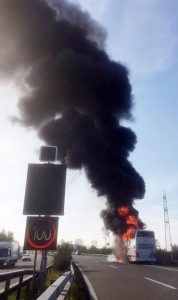Fires in coaches or public transport buses are a very rare event. The resulting hazard potential, however, significantly exceeds that of a car, as a larger number of affected persons must be assumed. Due to the construction, the evacuation of buses can be expected to be complicated by difficult conditions, in particular in the event of visibility being impaired by smoke in conjunction with panic reactions on the part of passengers.

Seats represent one of the main fire risks in coach interiors. The fire behaviour of the original component must be tested. Individual tests of the materials used, for example in accordance with DIN EN ISO 3582 [117], do not sufficiently reflect the real fire situation.
The seat must be equipped with all components that are also used in the bus. These include armrests, safety belts and pillows. Seat benches should be tested as such.
More informations...
The seats are tested with the UIC paper cushion in accordance with DIN 54341 or UIC 564-2, in accordance with the specifications and limit values from DIN 5510.
The test is carried out with a standardised 100g paper cushion, which is placed on the seat and ignited at the 4 corners. The test is considered passed if the flame does not exceed the height of the backrest by more than 45 cm, the armrests or the edges of the upholstery surface are not reached and the upholstery compound automatically extinguishes after max. 15 minutes.
A detailed investigation by DEKRA on bus fires also points to this:
“In principle, the testing of fire behaviour and the associated by-products must not be restricted to individual materials. Rather complete assemblies must be tested in the arrangements in which they are used in the coach. This is the only way to detect any negative mutual influences. In particular, components with separating functions must be tested for their behaviour when exposed to heat.”
This test procedure is also used for testing seats in rail vehicles. Individual materials such as upholstery fabrics or upholstery foams Furniture that have successfully passed the “paper cushion test” according to DIN 54341 have similar fire properties to building materials that are classified as “flame-retardant” (B1) according to DIN 4102 (B1 and B2).
The driver’s seat has to meet the same requirements. However, it is incomprehensible why the smoke development of seats in rail vehicles is not subject to any requirements. Such a requirement is considered necessary for the coach sector. In addition, the smoke development should be tested in accordance with DIN 54837. Both a sample from the seat cushion and a sample from the backrest should be tested, if different materials are used.
Unfortunately, the regulations for buses are not yet as optimal as those for rail vehicles.
However, over the past few years manufacturers have gradually tightened up the regulations applicable to buses on the burning behaviour of the materials used in the passenger compartment (“ECE R 118”).(Sorry in the moment just in German language)
There is a detailed study (Unfortunaltely only in german language) on this subject:
Reports of the Federal Highway Research Institute
Fire behavior of the interior of coaches Fahrzeugtechnik Heft F 51.
And here you can find another intersting study DEKRA emergency exits buses (June 2020).
Since January 1, 2019, all new tourist buses and double-deckers throughout the European Union must have a permanently mounted extinguishing system in the engine compartment. From 2021, this will also apply to intercity and city buses.
The regulations fall under UNECE-Regulation-107 and the requirements for the type of extinguishing system are based on a test procedure developed by SP in Sweden.
By the way:
Secondary fire protection, i.e. the organisation of fire protection, is primarily the responsibility of the bus holder!
He is responsible for the regular maintenance and repair of the vehicle and its equipment as well as for the immediate repair of critical defects.
The bus manufacturer MAN, for example, attaches great priority to the implementation of the specifications and the training of bus drivers. Here is a very vivid video:
The function of the fire protection measures provided for in the design must be checked on an ongoing basis.
Furthermore, he must train his drivers and accompanying personnel sufficiently. This should go beyond the requirement of Section 3 of § 35 g of the StVZO, which merely stipulates that the driving personnel must be familiar with the handling of the fire extinguisher carried. Rather, the correct behaviour in the event of a vehicle fire and evacuation measures would also have to be trained.
Petra Kottenstedte, for example, self-employed trainer and consultant and qualified for BKrFQG D95 training courses, therefore considers it very important to conduct extra safety training with bus pilots during her training courses. With blindfolded eyes, the participants should be able to find and release the emergency release of the bus. In the case of strong smoke in the event of a fire, visibility is so restricted that a bus pilot must be able to blindly find all safety-relevant equipment in his bus area.
Passenger information, for example through information cards at each seat, is also part of organisational fire protection. The use of fire extinguishers should be practiced regularly.
